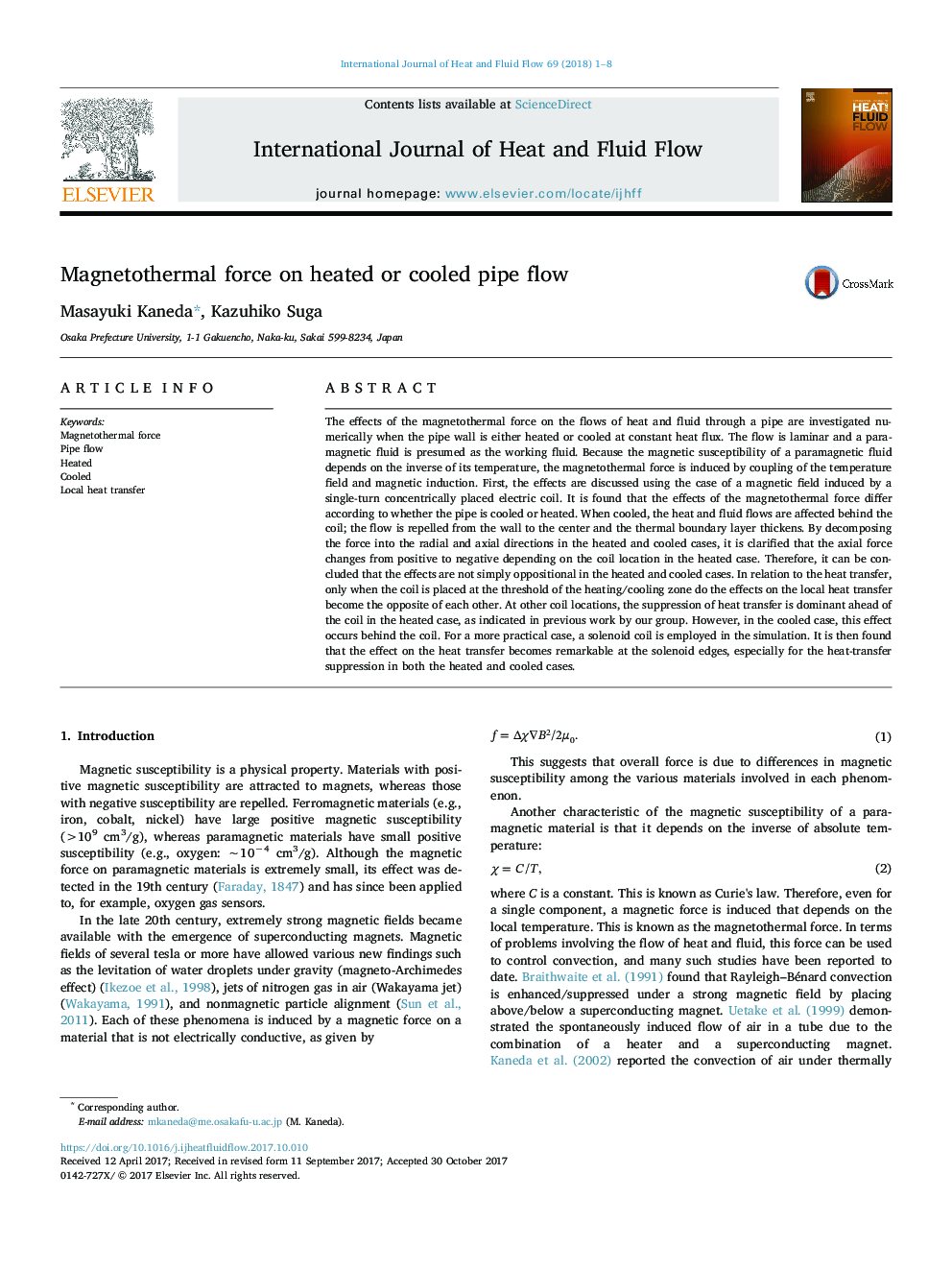| کد مقاله | کد نشریه | سال انتشار | مقاله انگلیسی | نسخه تمام متن |
|---|---|---|---|---|
| 7053522 | 1457609 | 2018 | 8 صفحه PDF | دانلود رایگان |
عنوان انگلیسی مقاله ISI
Magnetothermal force on heated or cooled pipe flow
ترجمه فارسی عنوان
نیروی مغناطیسی در جریان گرم یا سرد شده
دانلود مقاله + سفارش ترجمه
دانلود مقاله ISI انگلیسی
رایگان برای ایرانیان
کلمات کلیدی
نیروی مغناطیسی، جریان لوله، گرم شدن خنک انتقال حرارت محلی
ترجمه چکیده
اثرات نیروی مغناطیسی بر جریان گرما و مایع از طریق یک لوله به صورت عددی بررسی می شود زمانی که دیوار لوله یا گرم و یا سرد در شار گرما ثابت است. جریان جریان انعطاف پذیر است و یک مایع پارامغناطیس به عنوان مایع کار می شود. از آنجا که حساسیت مغناطیسی یک مایع پارامغناطیس بستگی به معکوس دمای آن دارد، نیروی مغناطیسی بوسیله اتصال میدان دما و القاء مغناطیسی ایجاد می شود. اولا اثرات مورد استفاده در مورد یک میدان مغناطیسی ناشی از کویل الکتریکی متمرکز به نوبه خود یک تک چرخان مورد بحث قرار می گیرد. مشخص شده است که اثرات نیروی مغناطیسی بر اساس اینکه آیا لوله سرد شده یا گرم شده است، متفاوت است. هنگام سرد شدن، جریان گرما و مایع در پشت سیم پیچ قرار دارد. جریان از دیوار به مرکز دفع می شود و لایه مرزی حرارتی ضخیم می شود. با تجزیه نیرو در جهت شعاعی و محوری در موارد گرم و سرد، مشخص شده است که نیرو محوری از نظر مثبت به منفی بسته به محل کویل در مورد گرم شده تغییر می کند. بنابراین، می توان نتیجه گرفت که اثرات در موارد گرم و سرد صرفا مخالف نیستند. در ارتباط با انتقال حرارت، تنها زمانی که کویل در آستانه منطقه گرمایی / خنک قرار می گیرد، اثرات بر روی انتقال گرمای محلی به مخالف یکدیگر تبدیل می شود. در دیگر مکان های کویل، سرکوب انتقال حرارت غلبه بر سیم پیچ در مورد گرم است، همانطور که در گروه قبلی ما نشان داده شده است. با این حال، در مورد سرد، این اثر در پشت کویل اتفاق می افتد. برای یک مورد عملی تر، یک سیم پیچ مولد در شبیه سازی استفاده می شود. سپس متوجه شدیم که اثر بر روی انتقال حرارت در لبه های حلقوی قابل توجه است، به خصوص برای سرکوب انتقال حرارت در هر دو مورد گرم و سرد.
موضوعات مرتبط
مهندسی و علوم پایه
مهندسی شیمی
جریان سیال و فرایندهای انتقال
چکیده انگلیسی
The effects of the magnetothermal force on the flows of heat and fluid through a pipe are investigated numerically when the pipe wall is either heated or cooled at constant heat flux. The flow is laminar and a paramagnetic fluid is presumed as the working fluid. Because the magnetic susceptibility of a paramagnetic fluid depends on the inverse of its temperature, the magnetothermal force is induced by coupling of the temperature field and magnetic induction. First, the effects are discussed using the case of a magnetic field induced by a single-turn concentrically placed electric coil. It is found that the effects of the magnetothermal force differ according to whether the pipe is cooled or heated. When cooled, the heat and fluid flows are affected behind the coil; the flow is repelled from the wall to the center and the thermal boundary layer thickens. By decomposing the force into the radial and axial directions in the heated and cooled cases, it is clarified that the axial force changes from positive to negative depending on the coil location in the heated case. Therefore, it can be concluded that the effects are not simply oppositional in the heated and cooled cases. In relation to the heat transfer, only when the coil is placed at the threshold of the heating/cooling zone do the effects on the local heat transfer become the opposite of each other. At other coil locations, the suppression of heat transfer is dominant ahead of the coil in the heated case, as indicated in previous work by our group. However, in the cooled case, this effect occurs behind the coil. For a more practical case, a solenoid coil is employed in the simulation. It is then found that the effect on the heat transfer becomes remarkable at the solenoid edges, especially for the heat-transfer suppression in both the heated and cooled cases.
ناشر
Database: Elsevier - ScienceDirect (ساینس دایرکت)
Journal: International Journal of Heat and Fluid Flow - Volume 69, February 2018, Pages 1-8
Journal: International Journal of Heat and Fluid Flow - Volume 69, February 2018, Pages 1-8
نویسندگان
Masayuki Kaneda, Kazuhiko Suga,
